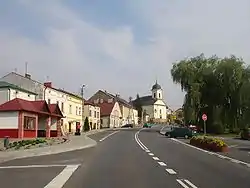Brzostek | |
|---|---|
Town | |
 Main street | |
 Coat of arms | |
 Brzostek | |
| Coordinates: 49°52′56″N 21°24′26″E / 49.88222°N 21.40722°E | |
| Country | |
| Voivodeship | |
| County | Dębica |
| Gmina | Brzostek |
| City rights | 1367-1934, 2009 |
| Government | |
| • Mayor | Wojciech Piotr Staniszewski |
| Area | 8.76 km2 (3.38 sq mi) |
| Population (31 December 2021[1]) | 2,760 |
| • Density | 320/km2 (820/sq mi) |
| Postal code | 39-230 |
| Area code | +48 14 |
| Car plates | RDE |
Brzostek [ˈbʐɔstɛk] is a town in Dębica County, Subcarpathian Voivodeship, south-eastern Poland (historic province of Lesser Poland). It is the seat of the gmina (administrative district) called Gmina Brzostek. As of December 2021, the town has a population of 2,760.[1] It lies on the Wisłoka river, in the foothills of the Carpathians, approximately 19 kilometres (12 mi) south of Dębica and 46 km (29 mi) west of the regional capital Rzeszów.[2] Brzostek is a local center of education and commerce.
History
Brzostek gained its Magdeburg rights in 1367, but first documented mentions of the town come from 1123 to 1125, when a list of possessions of the Benedictine Abbey in Tyniec was created. Among a number of villages specified in the document, there is Brzostek (spelt Brestek). For centuries Brzostek remained a small town, frequently destroyed in numerous wars and conflicts. In 1657 the town was burned by the forces of the Transylvanian prince George II Rákóczi, who crossed into Poland earlier in the year.
Following the partitions of Poland in the late 18th century, Brzostek along with most of the region became part of Austria and remained in Austria until World War I (1914–1918). On 18 February 1846 the Galician peasant revolt started in the town (see Jakub Szela), and in the second half of the 19th century, Ignacy Łukasiewicz opened his pharmacy here. In 1934 Brzostek lost its town status, as its population was under 3,000, too small to be officially called a town. Its Jewish population was murdered by the Germans in the Holocaust, Brzostek itself was 65% destroyed during World War II. It regained the town status on 1 January 2009.[3]
Main sights
Among points of interest there are 18th and 19th-century houses in the market square, roadside chapels (18th and 19th centuries), a Classicistic church (1818), and World War I military cemeteries.
See also
References
- 1 2 "Local Data Bank". Statistics Poland. Retrieved 2022-06-02. Data for territorial unit 1803024.
- ↑ "Central Statistical Office (GUS) - TERYT (National Register of Territorial Land Apportionment Journal)" (in Polish). 2008-06-01. Retrieved 2009-07-22.
- ↑ Ordinance of the Council of Ministers of the Republic of Poland Archived 2009-03-03 at the Wayback Machine (in Polish)
External links
- "Brzostek". Geographical Dictionary of the Kingdom of Poland (in Polish). 1. Warszawa: Kasa im. Józefa Mianowskiego. 1880. p. 421.
- "Brzostek". Geographical Dictionary of the Kingdom of Poland (in Polish). p. 248.
- History of the Jewish presence in Brzostek on Virtual Shtetl
- Documentary about the Reconsecration of the Jewish Cemetery in Brzostek produced by Handheldfeatures.com